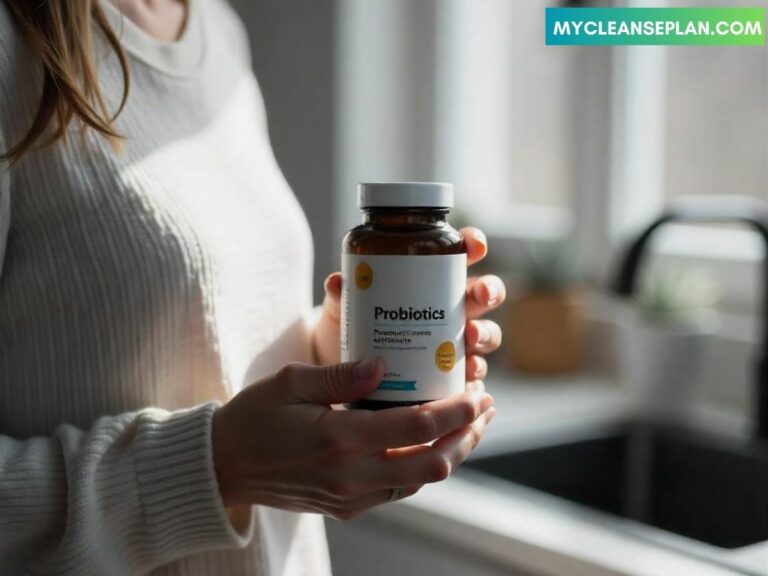10 Probiotic Drinks You Can Make at Home for Gut Health
Key Takeaways
- You will learn how to make probiotic drinks from scratch.
- You’ll discover the benefits of these drinks for your gut health.
- You can customize the recipes to fit your taste preferences.
- You will be able to improve your overall well-being.
- You can choose healthy and tasty alternatives.
- You’ll learn about different types of probiotics.
Remember that feeling after a holiday feast? Overstuffed, sluggish, and your stomach feeling like it’s throwing a party?
That’s your gut microbiome at work, or perhaps, not working as well as it could! Fortunately, taking care of your gut health doesn’t require complex ingredients or a costly subscription.
You can easily make your own probiotic drinks right at home. This guide will walk you through ten delicious and simple recipes, transforming your kitchen into a hub of gut-friendly goodness.
You’ll gain practical knowledge, empowering you to improve your digestive health and discover new and exciting flavors. Say goodbye to that bloated feeling and hello to a happier, healthier you!

The 10 Probiotic Drinks You Can Make at Home
The gut microbiome is a complex ecosystem containing trillions of microorganisms, including bacteria, fungi, viruses, and other microbes.
These tiny organisms significantly affect overall health, influencing digestion, immunity, and even mood.
A healthy gut microbiome is essential for well-being. Consuming probiotic drinks is an excellent way to support gut health. These drinks contain live microorganisms that can help restore balance to your gut flora.
This guide will help you create a range of delicious and easy-to-make probiotic beverages at home.
You can experience improved digestion, enhanced nutrient absorption, and a stronger immune system by incorporating them into your daily routine.
The recipes are straightforward, allowing even novice cooks to experiment with flavors and find their favorites.
1. Kefir
Kefir is a fermented milk drink with a slightly tart, tangy flavor. It is packed with probiotics, vitamins, and minerals. It can be made using kefir grains, which are a culture of bacteria and yeast that ferment the lactose in milk.
The fermentation process transforms milk into a nutritional powerhouse, rich in beneficial bacteria.
The benefits of kefir extend beyond gut health; it can also help to strengthen bones due to its high calcium content and improve the absorption of essential nutrients. Drinking kefir regularly can help you better manage your weight and reduce bloating.
Kefir grains are added to milk (dairy or non-dairy), and they feed on the lactose. The resulting fermentation creates the characteristic tangy taste and slightly bubbly texture of kefir. The longer the fermentation period, the tarter the kefir will be.
Once the kefir is ready, the grains are strained out. They can be reused to make more kefir. This creates a sustainable and cost-effective way to make a probiotic drink at home.
How to Make Kefir
- Place 1 tablespoon of kefir grains in a clean glass jar.
- Pour in 1 cup of milk (dairy or non-dairy).
- Cover the jar loosely with a lid or cloth.
- Allow the mixture to ferment at room temperature for 12-24 hours.
- Strain the grains from the kefir.
- Enjoy your homemade kefir!
Real-Life Example: A study by the American Journal of Clinical Nutrition found that kefir consumption improved gut health in people with lactose intolerance. This resulted in improved digestion and reduced symptoms like bloating and gas.
2. Yogurt Drinks
Yogurt drinks provide a delicious and convenient way to consume probiotics. They are made by blending yogurt with other ingredients such as fruits, vegetables, or sweeteners.
Yogurt contains live and active cultures that are beneficial for gut health. This makes yogurt drinks a great addition to any diet. Choosing the right yogurt is important for maximizing the benefits of the drink.
Look for yogurts that specifically list live and active cultures on their label, which ensures the presence of beneficial bacteria. These cultures can help restore the balance of good bacteria in the gut, promoting better digestion.
The beauty of yogurt drinks is their versatility. They can be customized to your taste. This allows you to create a probiotic drink that fits your dietary needs and preferences.
By adding fruits, you can increase the fiber content and add extra vitamins. Sweeteners like honey or maple syrup can be added, but consider using them in moderation.
Incorporating vegetables provides nutrients and antioxidants, making the drink even more beneficial.
Yogurt drinks can also be used as a base for smoothies and shakes. This makes them easy to incorporate into a breakfast routine or a healthy snack.
Making Your Own Yogurt Drink
- Start with one cup of plain yogurt (dairy or non-dairy).
- Add your choice of fruit. Berries, bananas, and mangoes are great choices.
- Blend until the mixture is smooth.
- Adjust the consistency with milk or water.
- Sweeten to taste with honey or a natural sweetener.
Sourced Statistic: According to the National Institutes of Health, regular yogurt consumption is associated with a lower risk of type 2 diabetes. This effect is possibly linked to the probiotics in yogurt, which improve gut health and insulin sensitivity.
3. Kombucha
Kombucha is a fermented tea beverage that originated in East Asia. It is made by adding a SCOBY (Symbiotic Culture of Bacteria and Yeast) to sweetened tea.
The SCOBY converts the sugar into probiotics, acids, and other beneficial compounds. The fermentation process also creates carbon dioxide, giving kombucha its characteristic fizz.
This makes it a refreshing and healthy drink. Kombucha offers a unique combination of probiotics, antioxidants, and vitamins, supporting overall health and well-being.
The fermentation process requires patience, and it can take anywhere from 7-30 days, depending on the temperature and other environmental factors.
The longer the fermentation period, the tarter the kombucha will taste. Kombucha can be flavored with a variety of fruits, herbs, and spices during a second fermentation.
This expands the possibilities for flavor profiles, allowing for endless customization. Homemade kombucha can be a cost-effective alternative to store-bought kombucha and a source of probiotics.
Steps for Making Kombucha
- Brew a strong batch of black or green tea.
- Add sugar to the hot tea and let it cool.
- Once cool, pour the tea into a clean glass jar.
- Add the SCOBY and some starter kombucha from a previous batch.
- Cover the jar with a cloth and secure it with a rubber band.
- Allow the kombucha to ferment for 7-30 days at room temperature.
- Once fermented, strain the kombucha, leaving the SCOBY behind.
- Add flavorings and bottle the kombucha for a second fermentation to build carbonation.
- Refrigerate and enjoy!
4. Water Kefir
Water kefir is a non-dairy alternative to milk kefir, making it suitable for people with lactose intolerance or those following a vegan diet. It is made by fermenting sugar water with water kefir grains. These grains are a collection of bacteria and yeasts.
They convert the sugar into probiotics and other beneficial compounds. Water kefir has a slightly sweet and fizzy taste. It can be easily flavored with fruits, herbs, and spices.
This makes it an enjoyable way to introduce probiotics into your diet. This offers all of the gut-health benefits of kefir in a dairy-free form.
The fermentation process for water kefir is quick, usually taking 24-48 hours. This makes it a great choice for those who are new to making probiotic drinks. The water kefir grains can be reused in subsequent batches.
This provides a sustainable and cost-effective way to enjoy probiotics regularly. Water kefir is a versatile beverage. It can be consumed on its own.
It can also be added to smoothies, juices, or used as a base for making flavored sodas. This expands your opportunities to include probiotic drinks in your daily routine.
How to Make Water Kefir
- Dissolve sugar in filtered water.
- Add water kefir grains to the sweetened water.
- Cover the jar loosely.
- Let it ferment at room temperature for 24-48 hours.
- Strain the grains from the water kefir.
- Add flavorings and bottle for a second fermentation if desired.
- Refrigerate and enjoy your water kefir!
Comparison Table:
| Drink | Base | Taste | Benefits | Suitability |
|---|---|---|---|---|
| Kefir | Milk (dairy or non-dairy) | Tangy, slightly acidic | Probiotics, calcium, bone health | Suitable for those who tolerate dairy, and also for non-dairy milk users. |
| Yogurt Drinks | Yogurt (dairy or non-dairy) | Variable, based on added ingredients | Probiotics, fiber, vitamins | Highly customizable, suitable for everyone. |
| Kombucha | Sweetened tea | Tart, fizzy | Probiotics, antioxidants | Requires a SCOBY and fermentation knowledge. |
| Water Kefir | Sugar water | Sweet, fizzy | Probiotics, dairy-free | Suitable for those who are lactose intolerant or vegan. |
5. Beet Kvass
Beet kvass is a traditional Eastern European fermented beverage made with beets. It is known for its earthy flavor and numerous health benefits.
Beets are naturally rich in nitrates. These can be converted into nitric oxide in the body, which improves blood flow.
The fermentation process also creates probiotics, making it a gut-friendly drink. Beet kvass is a powerhouse of nutrients, including vitamins, minerals, and antioxidants.
These components promote overall health and wellness. This creates a functional beverage that is both delicious and good for you.
The fermentation process is straightforward and typically takes 2-7 days. During fermentation, the beets release their natural sugars, which are then consumed by beneficial bacteria. This creates a slightly sour and fizzy drink.
Beet kvass can be consumed on its own or used as a base for soups, stews, or even salad dressings. This adds a unique flavor to your meals while providing health benefits.
It is also a sustainable and cost-effective option for incorporating probiotics and nutrients into your diet. This allows you to explore new flavors and improve your well-being.
Making Beet Kvass
- Wash and chop beets into small pieces.
- Place the beets in a clean glass jar.
- Add water and a small amount of salt.
- Cover the jar loosely and let it ferment at room temperature for 2-7 days.
- Strain the kvass and discard the beets (or use them in other recipes).
- Refrigerate and enjoy!
6. Sauerkraut Juice
Sauerkraut juice, the liquid produced during the fermentation of cabbage, is a potent source of probiotics and other beneficial compounds. It is known for its distinctive tangy flavor and numerous health benefits.
The fermentation process creates probiotics. These can help restore the balance of gut bacteria, improving digestion and promoting overall well-being. Sauerkraut juice is also rich in vitamins, minerals, and antioxidants.
This makes it a nutrient-dense beverage. Including sauerkraut juice in your diet can support gut health and boost your immune system.
The fermentation process of sauerkraut is similar to other fermented foods. It involves the use of salt and time.
The salt draws out the water from the cabbage, creating a brine. The cabbage is then submerged in this brine and left to ferment.
The beneficial bacteria naturally present on the cabbage convert the sugars into lactic acid. This process preserves the cabbage and creates the tangy flavor characteristic of sauerkraut.
The juice that results from this process is packed with probiotics. It also contains the same beneficial compounds as the sauerkraut itself.
How to Collect Sauerkraut Juice
- Make homemade sauerkraut by fermenting shredded cabbage with salt.
- Allow the sauerkraut to ferment for several weeks.
- The juice will accumulate in the jar during fermentation.
- Strain the sauerkraut.
- Collect the juice.
- Refrigerate and enjoy!
7. Fermented Pickles (Brine)
The brine from fermented pickles is another excellent source of probiotics and beneficial nutrients. Traditional fermented pickles are made by placing cucumbers in a saltwater brine and allowing them to ferment.
The fermentation process creates lactic acid bacteria, which are probiotics. These probiotics can help improve gut health and boost your immune system.
The brine, also known as pickle juice, contains the probiotics from the fermentation. It also provides the salty and tangy flavor associated with pickles.
The making of fermented pickles is a simple process. It involves salt, water, cucumbers, and time. Unlike vinegar-based pickles, which do not contain live cultures, fermented pickles undergo a natural fermentation process.
This allows the beneficial bacteria to thrive. The key to making good fermented pickles is to use a good-quality salt (non-iodized) and to ensure that the cucumbers remain submerged in the brine.
The brine can then be consumed on its own as a probiotic drink. It can also be added to other dishes to enhance the flavor and nutritional value.
How to Use Fermented Pickle Brine
- Use brine from traditionally fermented pickles.
- Enjoy the brine as a shot or mixed with water.
- Add it to your favorite recipes, such as salad dressings.
- Use it to add flavor to soups or stews.
8. Fermented Vegetable Juice
Fermented vegetable juice combines the benefits of juicing with the probiotic power of fermentation.
This produces a nutrient-rich and gut-friendly beverage. Any combination of vegetables can be used, creating a versatile and customizable drink.
The fermentation process introduces beneficial bacteria. These help preserve the juice and also produce probiotics. The result is a drink that not only tastes good but also provides a range of health benefits.
These include improved digestion, enhanced nutrient absorption, and a boost to the immune system. This allows you to include more vegetables in your diet.
The process involves juicing vegetables, adding a starter culture (such as whey from yogurt or a probiotic capsule), and allowing the mixture to ferment.
The fermentation process takes time. It can vary depending on the temperature and other environmental factors.
The longer the fermentation, the more complex the flavors become, and the more probiotics develop.
The fermented juice can be stored in the refrigerator, where the fermentation process slows down, preserving its flavor and nutritional value. The resulting fermented juice is a tasty and healthy way to add more vegetables to your diet.
Making Fermented Vegetable Juice
- Juice your favorite vegetables. Carrots, celery, and beets work well.
- Add a starter culture, such as whey or a probiotic capsule.
- Pour the juice into a clean jar.
- Allow it to ferment at room temperature for 1-7 days.
- Refrigerate and enjoy!
Scenario Example: Imagine you have a surplus of garden vegetables. You can transform them into a delicious and probiotic-rich juice. This helps you reduce food waste while getting a health boost.
9. Ginger Bug Soda
Ginger bug soda is a fizzy, probiotic-rich beverage made using a ginger bug, which is a fermented culture of ginger, sugar, and water. This creates a lively, naturally carbonated drink.
The ginger bug is made by fermenting ginger and sugar. It produces beneficial bacteria and yeast, which give the soda its probiotic properties.
The process is easy and results in a refreshing and healthful drink. It is a great alternative to commercial sodas.
The ginger bug can be used as a starter culture for making a variety of flavored sodas. Simply mix the ginger bug with fruit juice, herbs, or spices, and let it ferment.
The fermentation process creates carbonation and enhances the flavor. The longer the fermentation, the fizzier the soda will become.
Ginger bug soda offers a natural and probiotic-rich alternative to sugary sodas. It supports gut health. It also adds a unique and delicious flavor to your beverage choices.
Making Ginger Bug Soda
- Make a ginger bug by combining grated ginger, sugar, and water.
- Let the mixture ferment for 5-7 days, adding sugar and ginger daily.
- Strain the ginger bug.
- Mix the ginger bug with your favorite juice.
- Bottle the mixture and let it ferment for a few days to build carbonation.
- Refrigerate and enjoy your soda!
10. Fruit Kefir
Fruit kefir is another delicious and refreshing probiotic drink option. It is made by adding fruit and sugar to water kefir grains. This creates a naturally flavored and probiotic-rich beverage.
The water kefir grains ferment the sugar in the fruit and water. This produces probiotics and a light, effervescent texture. Fruit kefir is a versatile beverage. It allows you to experiment with various fruits and flavors.
This makes it an exciting addition to any diet. This gives you a refreshing drink with gut-health benefits.
The beauty of fruit kefir lies in its simplicity. You can use any type of fruit, fresh or dried. It requires water, sugar, and water kefir grains. The process is similar to making water kefir.
However, the added fruit infuses the drink with flavor. The fermentation process transforms the sugars in the fruit, creating a lightly sweetened and naturally carbonated beverage.
Fruit kefir offers the benefits of probiotics in a refreshing, fruity form. It’s a great option for people who are looking for alternatives to sugary drinks.
How to Make Fruit Kefir
- Add water kefir grains and sugar to water.
- Add your choice of fruit.
- Allow the mixture to ferment at room temperature for 24-48 hours.
- Remove the fruit and strain the grains.
- Refrigerate and enjoy your fruit kefir!
FAQ Of 10 Probiotic Drinks You Can Make at Home for Gut Health
What are probiotics?
Probiotics are live microorganisms, mainly bacteria and yeasts, that provide health benefits when consumed. They help to balance the gut flora, improving digestion and boosting the immune system.
Why are probiotics good for you?
Probiotics can improve digestion, strengthen the immune system, and promote overall health. They help to restore balance to your gut microbiome and enhance nutrient absorption.
What’s the difference between probiotics and prebiotics?
Probiotics are live beneficial bacteria, while prebiotics are non-digestible fibers that feed these bacteria, helping them thrive in the gut.
Can I make probiotic drinks if I’m lactose intolerant?
Yes! Many probiotic drinks, like water kefir and kombucha, are naturally dairy-free. Also, some dairy-based options like yogurt drinks can be made using lactose-free yogurt alternatives.
How often should I drink probiotic drinks?
You can enjoy probiotic drinks daily. Start with small amounts and increase gradually. Listen to your body and adjust your intake based on your individual needs and tolerance.
Final Thoughts
Incorporating probiotic drinks into your daily routine is an accessible and enjoyable way to nurture your gut health and overall well-being.
This guide has shown you ten easy recipes. From the tangy delight of kefir to the fizzy refreshment of ginger bug soda, you can explore many flavors and benefits.
You have the power to create a healthier gut environment. With simple ingredients and straightforward techniques, you can explore various options High-Quality Dental Bonding in Kingston NY.
Embrace the opportunity to experiment and tailor your probiotic beverage selection to align with your taste preferences and dietary requirements.
This journey isn’t just about making drinks; it’s about investing in a happier, healthier you. Start experimenting with these recipes and savor the benefits of a flourishing gut microbiome!


![Prebiotic Fiber Trends Popular Types of Fiber on the Rise[1]](https://mycleanseplan.com/wp-content/uploads/2025/10/Prebiotic_Fiber_Trends__Popular_Types_of_Fiber_on_the_Rise1-768x448.jpg)
![The Gut Benefits of Mushroom Polysaccharides A Gut Health Guide[1]](https://mycleanseplan.com/wp-content/uploads/2025/10/The_Gut_Benefits_of_Mushroom_Polysaccharides__A_Gut_Health_Guide1-1-768x448.jpg)
![10 Causes of Morning Stomach Discomfort Why You Feel Awful[1]](https://mycleanseplan.com/wp-content/uploads/2025/11/10_Causes_of_Morning_Stomach_Discomfort__Why_You_Feel_Awful1-768x448.jpg)

